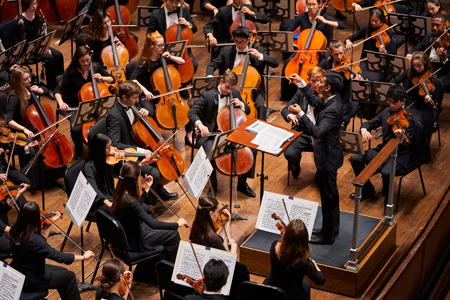by Mike Telin

On Sunday, November 21 at 3:00 pm in Mandel Hall at Severance, Parameswaran will lead the Cleveland Orchestra Youth Orchestra in a program that features music by Joan Tower, Howard Swanson, Aaron Copland, and Antonín Dvořák. Tickets are available online.
Parameswaran said that during the first rehearsals, he, along with the returning and roughly 40 new members spent a good deal of time getting to know each other and figuring out how to make things work. “It’s amazing how much everyone has progressed over the past couple of months. But I know all of the musicians were chomping at the bit to get back into Severance and make music together.”
The conductor noted that Sunday’s program spans three distinct styles from three American composers, one of whom spent his formative years in Cleveland.
African American composer Howard Swanson was born in Atlanta in 1907 and his family relocated to Cleveland in 1916. He attended the Cleveland Institute of Music and later studied with Nadia Boulanger in Paris. In 1952 Swanson’s Short Symphony won the Music Critics Circle Award. The work was played more than any other new piece from its premiere in 1950 until the end of 1952.

Parameswaran pointed out that after hearing Swanson perform one of his own piano sonatas, Dimitri Mitropoulos commissioned him to write a symphony for the New York Philharmonic. That work was the Short Symphony.
“The piece made its rounds in the early ‘50s — New York played it and Rudolph Ringwald conducted it with The Cleveland Orchestra. Then it kind of just disappeared. It’s a piece, like so many from that era, that got lost in history, which is too bad because it is wonderful. It’s amazing how in twelve minutes he compresses everything that you expect to hear in a 40-minute piece. I know the musicians in COYO have enjoyed the challenge of learning it, because it is a challenge. But they also recognize that it is important to find these lost voices.”

The third American work is Copland’s Suite from Appalachian Spring. “I think that even for younger musicians there is a familiarity to it,” Parameswaran said. “There’s an emotional arc that as an American, if you grow up here, you can connect with the music like ‘Simple Gifts’ and the square dance tune.”
The conductor said that for the COYO musicians, the most challenging part hasn’t been the work’s complicated rhythms but rather its delicate moments. “The places where less is more. It’s funny how that can be a challenge. But if you do what Copland says to do, it works and that’s what makes the piece so satisfying.”
Sunday’s concert will conclude with Dvořák’s Symphony No. 7, which Parameswaran said is his favorite of the composer’s symphonies. “The ‘New World’ may be more popular but the 7th, from front to back, is just the best. It has everything — it’s his ‘Pathétique’ symphony — it has gravitas, drama, rhythmic spirit, and some of the most beautiful melodies you’ll hear from Dvořák. As a conductor what I love about it is the musical lines that are underneath the melody. And he saves the major key just for the last few bars. It’s really amazing.”
Published on ClevelandClassical.com November 16, 2021.
Click here for a printable copy of this article



